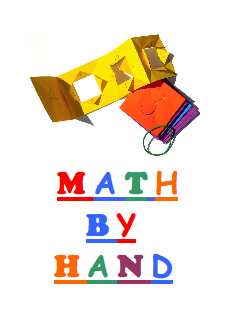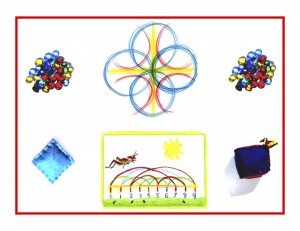
Day 96
For one year, 365 days, this blog will address the Common Core Standards from the perspective of creating an alternate, ambient learning environment for math. Ambient is defined as “existing or present on all sides, an all-encompassing atmosphere.” And ambient music is defined as: “Quiet and relaxing with melodies that repeat many times.”
Why ambient? A math teaching style that’s whole and all encompassing, with themes that repeat many times through the years, is most likely to be effective and successful. Today’s post will continue with the Common Core Standards for Grade 1, listed in blue and followed by their ambient counterparts.
Operations and Algebraic Thinking 1.OA
Represent and solve problems involving addition and subtraction.
2. Solve word problems that call for addition of three whole numbers whose sum is less than or equal to 20, e.g. by using objects, drawings, and equations with a symbol for the unknown number to represent the problem.
This can be easily demonstrated and carried out using the stories and plays. Here”s an example: “Three villagers needed enough wool to make blankets for their households. They would share in the tasks of washing, carding, and spinning the wool, then equally share the yarn needed to knit warm woolen blankets. Each villager was able to contribute some jewels to buy the wool from the shepherd. Here are the amounts that each could contribute: 2 jewels, 4 jewels, and 5 jewels. What is the sum of the jewels the villagers could give the shepherd for the wool?” The green color strip with four folded squares could be used here, placing 2 glass gems in the first square, 4 in the second, and 5 in the third. The white square, indicating the sum, would be placed in the fourth folded square to hold the sum, 11 gems.
As mentioned yesterday, any of the other spaces could be used for the white square and the question could be rephrased like, “The villagers needed 11 jewels to buy the wool. One villager had 5 and another had 4. How many jewels would the third villager need to add to make 11?” Re the uneven amounts, this could be added, “Some villagers had more jewels than others, but they were happy to make up for those who had less because the poorer villagers took on extra tasks and helped in other ways.”
Math, or any other subject, should not be made to stand alone, apart from life. The moral element is just as if not more crucial, and children constantly need and look for this sort of guidance. This is one of the many reasons that abstract word problems are harmful. They leave a void where moral guidance should be. And beyond that, it is imperative that children be taught from the whole to the parts. For example, the introduction to the numbers should begin with the whole and proceed to parts. Math By Hand suggests that a piece of fruit be cut up to show how 1 can become 2, 2 becomes 4, etc. This comes back for fractions in Grade 4 to show how 1 becomes 2 halves, 2 halves become 4 quarters, etc. Abstraction is the death of learning for a young child, until age 11 or 12 when it can be introduced gradually. Until then, all must be kept whole and concrete.
Knowledge ensues in an environment dedicated to imaginative, creative knowing, where student and teacher alike surrender to the ensuing of that knowledge as a worthy goal. Tune in tomorrow for more Common Core Grade 1 Operations and Algebraic Thinking Standards along with their ambient counterparts.
Tags:

Day 95
For one year, 365 days, this blog will address the Common Core Standards from the perspective of creating an alternate, ambient learning environment for math. Ambient is defined as “existing or present on all sides, an all-encompassing atmosphere.” And ambient music is defined as: “Quiet and relaxing with melodies that repeat many times.”
Why ambient? A math teaching style that’s whole and all encompassing, with themes that repeat many times through the years, is most likely to be effective and successful. Today’s post will begin looking at the Common Core Standards for Grade 1, listed in blue and followed by their ambient counterparts.
Operations and Algebraic Thinking 1.OA
Represent and solve problems involving addition and subtraction.
1. Use addition and subtraction within 20 to solve word problems involving situations of adding to, taking from, putting together, taking apart, and comparing, with unknowns in all positions, e.g., by using objects, drawings, and equations with a symbol for the unknown number to represent the problem.
Staying within 20 is perfect for a first foray into calculation. One of the most crucial differences between mainstream and Waldorf education is introducing all four processes at once. Calculations are kept under 20 for all, and a distinct advantage is being able to work with equivalency from the very beginning. Word problems are taken from the story or play so they stay in context, rather than being abstracted by basing them on random situations. (See the Peanuts cartoon at the bottom of this post.) Unconnected word problems are alienating and therefore less motivating. Situations can be widely varied as they fit into the context of the plays and stories. Maniplulatives too should be anchored in the reality of the plays and stories, as the Math By Hand glass gems are. Since they are considered as jewels used for payment, i.e., villagers trading with farmers, shepherds, and fishermen for their wares. The Math By Hand calculation strips are color coded to fit each of the processes, with a white square used for the unknown number. So at first no equation signs are needed because the strips are color coded. Each square can be filled with a number of gems, with the white (or blank) square able to be placed anywhere within the equation. Using the strips with the gems is a first step that can progress to using real numbers and operations signs on the strips, then to calculations with pencil and paper.
Knowledge ensues in an environment dedicated to imaginative, creative knowing, where student and teacher alike surrender to the ensuing of that knowledge as a worthy goal. Tomorrow we will continue with the Common Core Grade 1 Operations and Algebraic Thinking Standards along with their ambient counterparts.

Tags:

Day 94
For one year, 365 days, this blog will address the Common Core Standards from the perspective of creating an alternate, ambient learning environment for math. Ambient is defined as “existing or present on all sides, an all-encompassing atmosphere.” And ambient music is defined as: “Quiet and relaxing with melodies that repeat many times.”
Why ambient? A math teaching style that’s whole and all encompassing, with themes that repeat many times through the years, is most likely to be effective and successful. Today’s post will focus on the fourth and last pair of Mathematical Practice Standards, listed in blue and followed by their ambient counterparts. Because there are so many parallels in standard #7 to the ambient Grade 1 math practices, this standard will be taken apart and looked at in detail. As for #8, most of the possible applications are too advanced for Grade 1 so it will be just briefly reviewed.
The Standards for Mathematical Practice, Grade 1
#7 and #8: Seeing structure and generalizing.
7. Look for and make use of structure.
Mathematically proficient students look closely to discern a pattern or structure.
The Waldorf Grade 1 curriculum begins with a steeping in structure and pattern. Form drawing provides a first look at geometry as it relates to each number from 1 to 12. This awareness of pattern is essential since it not only translates later to an understanding of the principles of geometry, but more importantly it provides a bright and engaging glimpse into the truly beautiful face of mathematics. And this above all else can generate the spark that motivates learning (and teaching)!
Young students for example might notice that three and seven more is the same amount as seven and three more, or they may sort a collection of shapes according to how many sides the shapes have.
The first, noticing equivalency as a pattern happens easily when using the color calculation strips (mentioned yesterday) side by side to show relationship within each or between two or more processes. Secondly, sorting shapes may not happen by exploring shapes using a tub of plastic, foam, or wooden manipulatives, but will register on a deeper level through exposure to the properties of geometry through form drawing. For example, an instinctual recognition of the different properties of the square and triangle results when they are both presented with a story and/or picture for support.
Later, students will see 7 x 8 equals the well-remembered 7 x 5 + 7 x 3, in preparation for learning about the distributive property.
Having seen examples of Common Core practices and worksheets where a simple 2 or 3-step process becomes an elaborate, overly complicated, multi-step procedure, I have little faith in the effectiveness of exposing K-3 students to this level of abstract thinking. It’s confusing, so rote memorization along with looking for patterns in the times tables as prompts are much more effective at this age. The distributive property is taught with extensive story and pictorial support, but not until Grade 2.
They recognize the significance of an existing line in a geometric figure and can use the strategy of drawing an auxiliary line for solving problems.
Form drawing builds an effective foundation for this advanced function as the significance of every line is recognized as essential to the structure as a whole. An early exposure to the compelling beauty of geometry is more advantageous than anything else to grasping its abstract principles later on.
8. Look for and express regularity in repeated reasoning.
This points to a recognition of repetition as the foundation for using methods and shortcuts in calculation. If the right solid, foundational elements are provided now it paves the way for this sort of recognition later. One element, that of maintaining oversight of the process, while attending to the details, may be applicable at this level. Awareness of the “big picture” along with the building blocks that make it up is a consistent focus in all Waldorf grade levels. The macro is not sacrificed to the micro or vice versa but instead, a healthy balance between the two is always maintained. This may very well result in a responsible, morally integrated individual in right relationship to the world, the community, and the environment.
Knowledge ensues in an environment dedicated to imaginative, creative knowing, where student and teacher alike surrender to the ensuing of that knowledge as a worthy goal. Tomorrow we begin to look at the Common Core Grade 1 Operations and Algebraic Thinking Standards along with their ambient counterparts.
Tags:
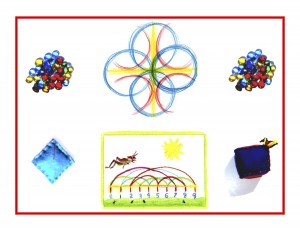
Day 92
For one year, 365 days, this blog will address the Common Core Standards from the perspective of creating an alternate, ambient learning environment for math. Ambient is defined as “existing or present on all sides, an all-encompassing atmosphere.” And ambient music is defined as: “Quiet and relaxing with melodies that repeat many times.”
Why ambient? A math teaching style that’s whole and all encompassing, with themes that repeat many times through the years, is most likely to be effective and successful. Today’s post will focus on the second pair of standards which will be listed in blue, followed by their ambient counterparts.
The Standards for Mathematic Practice, Grade 1
#2 and #3: Reasoning and explaining.
2. Reason abstractly and quantitatively.
A 6-7 year old does not yet have the capacity to reason, much less abstractly. If the ego is not yet developed, there is no solid wall to bounce ideas off of. Steiner’s philosophy of child development, which runs parallel to Piaget’s, says that the ability to reason begins at age 7, begins being the operative word. Readiness is all. When a ripeness to learn is there, learning will occur with relative ease. A young child can be drilled and coached so abstract concepts are parroted back, and all of this can be effectively remembered as well, but much is lost in the process, and more to the point the subject taught in this way will engender resentment and dislike, often for life. This does not mean that math cannot be taught at this age, to the contrary, a lively love of the subject that can carry it lifelong can be implanted. And even the so-called abstract concepts can be presented successfully if safely ensconced in story and pictures. Make the abstract concrete and you will not only be able to teach abstraction and quantity, but you will teach it more effectively than you can imagine possible!
3. Construct viable arguments and critique the reasoning of others.
Again, the ability to argue or prove a point is not yet available to the 6-7 year old. If the foundation is well-built, argument and proofs will come along in due time. Both Piaget and Steiner posit that abstract reasoning cannot be expected until age 11 or 12. I’ve watched Common Core videos in which the teacher guided groups of students to exchange ideas and explain how they arrived at their answers. Often, individuals are told that though they’ve arrived at the right answer, they need to collaborate with others in their group to fulfill the (Common Core) requirement. At this age, there is a strongly compelling desire or need to please the teacher or parent. So the groups may go through the motions of collaboration, but it will be against the grain of healthy development. First graders are ready and willing to be disciples in the true sense of the word. Ready and willing to learn, but in a safe, protected environment the teacher constructs and conducts with discipline. Waiting for readiness is wise, and no time is lost rather healthy growth and wisdom are gained!
For four days, each of the four pairs of Mathematical Practice Standards will be examined with an eye toward what works as developmentally appropriate math in Grade 1, continuing with standards 4 & 5. Knowledge ensues in an environment dedicated to imaginative, creative knowing, where student and teacher alike surrender to the ensuing of that knowledge as a worthy goal.
Tags:
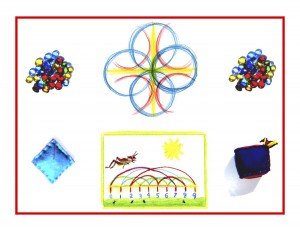
Day 91
For one year, 365 days, this blog will address the Common Core Standards from the perspective of creating an alternate, ambient learning environment for math. Ambient is defined as “existing or present on all sides, an all-encompassing atmosphere.” And ambient music is defined as: “Quiet and relaxing with melodies that repeat many times.”
Why ambient? A math teaching style that’s whole and all encompassing, with themes that repeat many times through the years, is most likely to be effective and successful. In reviewing the eight Standards for Mathematical Practice Grade 1, I must say that I’m struck by how developmentally inappropriate they are. Today’s post will focus on the first pair of standards which will be listed in blue, followed by their ambient counterparts.
The Standards for Mathematic Practice, Grade 1
#1 and #6: Overarching habits of mind of a productive mathematical thinker.
1. Make sense of problems and persevere in solving them.
Math must make sense in and of itself. If it’s presented in an artistic and holistic way, the beauty of math is communicated and carries the day. It can be thought of as painless and inspiring and learned “all of a piece” rather than having to be taken apart and abstracted. When math is approached in this way, initiative builds in a natural way, and this leads to the initiative to solve problems! But ironically, there really are no problems (to quote John Lennon) there are “only solutions.” Joy in practicing mathematics leads to mastery, with no actual need for perseverance, because the sense that’s gained is so gratuitous, and therefore completely relevant within the child’s world.
6. Attend to precision.
No need to consciously attend to precision if math is allowed to be itself, in the presence of the child and the lesson. Expecting the 6-7 year old child to detach from this experience to the extent that s/he has to consciouslyrefocus is an artificial construct. If a child is given the gift of faith and trust in the process, the native, natural affinity for the subject will surface. So as a parent-teacher, your belief and confidence in the ability of the child, and in the magnetic beauty of math will be the true teacher, and will lead the child to real success in math. And beyond that practical goal, shows the child how to live in the world as a participant in the deepest sense.
For four days, each of the four pairs of Mathematical Practice Standards will be examined with an eye toward what works as developmentally appropriate math in Grade 1, continuing with standards 2 & 3. Knowledge ensues in an environment dedicated to imaginative, creative knowing, where student and teacher alike surrender to the ensuing of that knowledge as a worthy goal.
Tags:
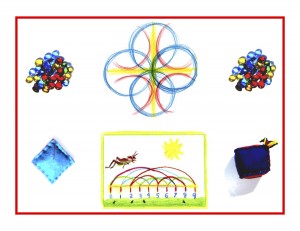
Day 90
Day 90
For one year, 365 days, this blog will address the Common Core Standards from the perspective of creating an alternate, ambient learning environment for math. Ambient is defined as “existing or present on all sides, an all-encompassing atmosphere.” And ambient music is defined as: “Quiet and relaxing with melodies that repeat many times.”
Why ambient? A math teaching style that’s whole and all encompassing, with themes that repeat many times through the years, is most likely to be effective and successful. Before reviewing the eight Standards for Mathematical Practice, Grade 1, I must say that I’m struck by how developmentally inappropriate they are. In the next four days, I will address each pair of standards from a Waldorf perspective. But for now, I’d like to share this wonderful talk by Child Psychologist, Dr. Megan Koschnick on why the Common Core Standards are developmentally inappropriate for grades K-3.
From the video:
“Why do we care if [Common Core standards] are age inappropriate? Well, you can answer that with one word — stress,” said Dr. Megan Koschnick during her presentation. “Instead of thinking about what’s developmentally appropriate for kindergarteners, they are thinking [college] is where we want this kindergartener to end up, so let’s back track down to kindergarten and have kindergarteners work on these skills from an early age. This can cause major stress for the child because they are not prepared for this level of education.”
Over the next four days, each of the four groups of Mathematical Practice Standards will be examined with an eye toward what really works as developmentally appropriate math in Grade 1, beginning with standards 1 & 6, tomorrow. Knowledge ensues in an environment dedicated to imaginative, creative knowing, where student and teacher alike surrender to the ensuing of that knowledge as a worthy goal.
#mce_temp_url#
Tags:
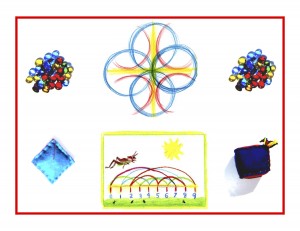
Day 89
For one year, 365 days, this blog will address the Common Core Standards from the perspective of creating an alternate, ambient learning environment for math. Ambient is defined as “existing or present on all sides, an all-encompassing atmosphere.” And ambient music is defined as: “Quiet and relaxing with melodies that repeat many times.”
Why ambient? A math teaching style that’s whole and all encompassing, with themes that repeat many times through the years, is most likely to be effective and successful. As promised, today’s post will review the eight Standards for Mathematical Practice, Grade 1. For an in-depth look at these standards, see Days 36 to 43, and note that though these posts focus on Kindergarten rather than Grade 1, they do offer an in-depth analysis of the standards as they compare with the philosophy and methodology of Waldorf education.
These are the eight Standards for Mathematical Practice, grouped into four categories.
1. Make sense of problems and persevere in solving them.
2. Reason abstractly and quantitatively.
3. Construct viable arguments and critique the reasoning of others.
4. Model with mathematics.
5. Use appropriate tools strategically.
6. Attend to precision.
7. Look for and make use of structure.
8. Look for and express regularity in repeated reasoning.
1 & 6 = Overarching habits of mind of a productive mathematical thinker.
2 & 3 = Reasoning and explaining.
4 & 5 = Modeling and using tools.
7 & 8 = Seeing structure and generalizing.
Over the next four days, each of the four groups will be examined with an eye toward what really works as developmentally appropriate math in Grade 1, beginning with standards 1 & 6, tomorrow. Knowledge ensues in an environment dedicated to imaginative, creative knowing, where student and teacher alike surrender to the ensuing of that knowledge as a worthy goal.
Tags:
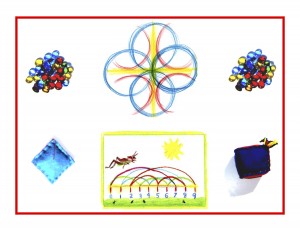
Day 88
For one year, 365 days, this blog will address the Common Core Standards from the perspective of creating an alternate, ambient learning environment for math. Ambient is defined as “existing or present on all sides, an all-encompassing atmosphere.” And ambient music is defined as: “Quiet and relaxing with melodies that repeat many times.”
Why ambient? A math teaching style that’s whole and all encompassing, with themes that repeat many times through the years, is most likely to be effective and successful. Now that a foundation has been built, so numbers are known in a deeper way than mere rote recognition, an affinity for the subject can begin to take root.
The dictionary defines affinity as: empathy for, rapport with, sympathy for, accord with, harmony with, relationship with, bond with, fellow feeling for, closeness with/to, understanding of/for, fondness of/for. ANTONYMS aversion, dislike. The first half of the Grade 1 year must be devoted to building a love of math, thus avoiding an aversion to or dislike for it.
Now that a foundation has been built, and all 4 processes have been introduced, it is time for the numbers to come together in calculation. We can now revisit the Common Core Grade 1 Math Standards, beginning with the Grade 1 overview, listed below in blue and followed by ambient alternatives.
CCSS Grade 1 Overview
Operations and Algebraic Thinking
Represent and solve problems involving addition and subtraction.
Understand and apply properties of operations and the relationship between addition and subtraction.
Add and subtract within 20.
Work with addition and subtraction equations.
As stated above, all 4 processes should be worked with at once. It’s possible to see their natural relationships early on, and since multiplication and division are not intrinsically more difficult than addition and subtraction if kept to single digits under 20, this is absolutely doable. Common Core proponents speak of the necessity to work in depth, but it seems their intent is to promote a deep but abstract understanding of the underlying method, so that math cannot be appreciated in all its layers as profoundly beautiful with yes, even moral implications.
As Albert Einstein said, “It is not enough to teach a man a specialty. Through it he may become a kind of useful machine but not a harmoniously developed personality. It is essential that the student acquire an understanding of and a lively feeling for values. He must acquire a vivid sense of the beautiful and of the morally good. Otherwise he—with his specialized knowledge—more closely resembles a well-trained dog than a harmoniously developed person.”
Number and Operations in Base Ten
Extend the counting sequence.
Understand place value.
Use place value understanding and properties of operations to add and subtract.
Traditionally, in both national and most if not all state standards (pre-Common Core) the requirement has been counting up to 100 for Grade 1, no set requirement for Kindergarten. Place value per se is best saved for mid to late Grade 2. It can be touched on with very experiential, concrete and imaginative activities, but should not be formally taught yet. Properties of operations can be used to add, subtract, multiply, and divide.
Measurement and Data
Measure lengths indirectly and by iterating length units.
Tell and write time.
Represent and interpret data.
Time and measurement should not be taught formally until Grade 3 for reasons cited earlier. Of course there will be informal awareness at first, but abstracting either one too early can be detrimental to optimal, healthy learning. Developmental awareness is key, so that teaching anything when the time is right and ripe is best. A butterfly in its cocoon is an apt analogy. Nothing is gained and the butterfly is lost, if extracted from the cocoon prematurely.
Geometry
Reason with shapes and their attributes.
See this blog, Day 55 for an ambient, form drawing related alternative to this standard.
Knowledge ensues in an environment dedicated to imaginative, creative knowing, where student and teacher alike surrender to the ensuing of that knowledge as a worthy goal. Tune in tomorrow for the eight CCSS Mathematical Practice Standards and their ambient alternatives.
Tags:
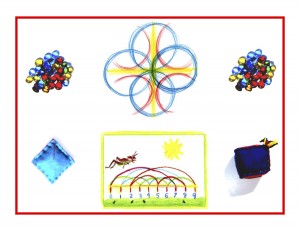
Day 87
For one year, 365 days, this blog will address the Common Core Standards from the perspective of creating an alternate, ambient learning environment for math. Ambient is defined as “existing or present on all sides, an all-encompassing atmosphere.” And ambient music is defined as: “Quiet and relaxing with melodies that repeat many times.”
Why ambient? A math teaching style that’s whole and all encompassing, with themes that repeat many times through the years, is most likely to be effective and successful. Because the Common Core Grade 1 Math Standards address addition and subtraction exclusively, they will appear here later, in conjunction with the blocks that focus on the 4 processes. Earlier math blocks focus on meeting the numbers up close and personal through stories, movement, art, form drawing, and hands-on activities like making real numbers. The numbers should come together for calculation only after an in-depth introduction has established them as friendly and personable, so essential for circumventing math fears and phobias!
Introduce the 4 processes pictorially and through movement, plays and stories. Create plays and stories around the four personalities, so they become knowably approachable. Have each one appear on the page every time its process is learned or practiced, with its formal or informal name and respective color. As you proceed with the 4 processes, keep all of the characters alive and relevant through continually relating stories that illustrate the key qualities of each one. The stories below are excepts from the Math By Hand Grade 1 Daily Lesson Plans book. The Daily Lesson Plans books for Grades 1 and 2 are so new they have not yet made it to our Shop page! But they can be purchased by special arrangement. See the Grade 1 Daily Lesson Plans book for the complete stories . . .
Knowledge ensues in an environment dedicated to imaginative, creative knowing, where student and teacher alike surrender to the ensuing of that knowledge as a worthy goal. Back to the Common Core Grade 1 Math Standards tomorrow, as we move along to calculation.
Once there was a kingdom where 4 special children lived. Each one was different from the others, but in spite of their differences they got along well. All good friends. they always helped each other. More importantly, the kingdom itself could not get along without them. The King gave them honorary names and decreed that each wear an especially bright color so everyone would know who each one was at first sight.
PLUS was dressed all in green because like the lush plants, grass, and herbs that graced the land, she was always growing and glowing . . .
PLUS never rested until the job was done. If it weren’t for her, many of the jobs needed to keep the kingdom alive would fall by the wayside . . . PLUS, all in green, was a treasure to the kingdom. Without her, nothing would ever be added together.
MINUS was dressed all in blue because he was always so sad, thinking that because he had a tendency to lose things, he couldn’t be trusted . . .
MINUS never had much, but he was always willing to give away what little he had . . . MINUS, all in blue, was a treasure. Without him, the poor and needy might not be seen and helped.
DIVIDE was dressed all in red because she was so decisive! Whenever the King needed a strong, fair person to take charge and keep things in order, he called on DIVIDE . . .
DIVIDE was respected because she could be counted on to step in and make all the tough decisions, but decision making sometimes made her feel that she alone was right . . . DIVIDE, all in red, was a treasure. Without her, the kingdom would often be stuck in confusion and indecision.
TIMES was dressed all in yellow because he was so happy! TIMES could always be counted on to bring more and more and more . . .
TIMES was appreciated because he lightened the mood, making others happy too . . . TIMES all in yellow, was a treasure. Without him, there wouldn’t be nearly as much fun or parties, nor would the kingdom be so efficiently organized.
Tags:
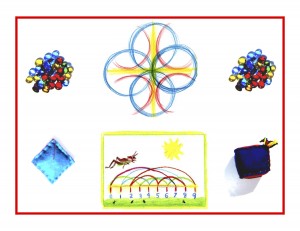
Day 86
For one year, 365 days, this blog will address the Common Core Standards from the perspective of creating an alternate, ambient learning environment for math. Ambient is defined as “existing or present on all sides, an all-encompassing atmosphere.” And ambient music is defined as: “Quiet and relaxing with melodies that repeat many times.”
Why ambient? A math teaching style that’s whole and all encompassing, with themes that repeat many times through the years, is most likely to be effective and successful. Because the Common Core Grade 1 Math Standards address addition and subtraction exclusively, they will appear here later, in conjunction with the blocks that focus on the 4 processes. Earlier math blocks focus on meeting the numbers up close and personal through stories, movement, art, form drawing, and hands-on activities like making real numbers. The numbers should come together for calculation only after an in-depth introduction has established them as friendly and personable, so essential for circumventing math fears and phobias!
Introduce the 4 processes pictorially and through movement, plays and stories. Create plays and stories around the four personalities, so they become knowably approachable. Have each one appear on the page every time its process is learned or practiced, with its formal or informal name and respective color.
Stories and plays can be the vehicles for presenting the characters, having each of their personalities and “jobs” as a focus. Math By Hand supplies the materials to make 4 hats and pouches in red, yellow, blue, and green, to be used as costuming for the plays and stories, or to wear when working with each of the processes. Here’s the synopsis of a Grade 1 play, to be presented in the middle of Block 2, after the real numbers’ activities are complete:
Cast of Characters:
The King
Villagers
Farmers
Shepherds
The 4 Processes Characters
Plot:
Farmers, shepherds, and anyone else with wares for sale bring the wares to the village storehouse, where the villagers, the King and his court all come to buy. The 4 Processes characters are given jobs that fit each of their strengths and capabilities
Plots should be simple with all of the characters true to type, with interactions that bring out their personalities and differences. There are many possibilities for casting the roles. For example, fewer than 4 children could take turns by changing hats and switching characters, with the parent or teacher playing the roles of the villagers and King.
Math By Hand supplies Doll Pins dressed as the 4 characters (see below), which may be more appropriate for 1 or 2 to act out the stories or plays. The foundational connections to the 4 Processes, attained by steeping them in colors and characters, will reap a lifelong benefit: an affinity for and appreciation of math.
Knowledge ensues in an environment dedicated to imaginative, creative knowing, where student and teacher alike surrender to the ensuing of that knowledge as a worthy goal. Do tune in tomorrow for the special jobs the King assigned each of the 4 Processes characters.

Tags:

